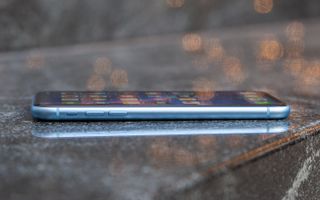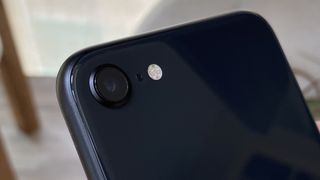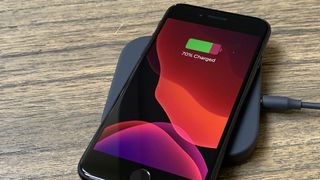iPhone SE vs iPhone XR: What should you buy?
The iPhone SE (2020) and iPhone XR are both excellent phones for those on a budget. Here’s how they stack up

Update: The iPhone XR has officially been discontinued, as has the iPhone SE (2020) now that the iPhone SE (2022) is here. Check out our best iPhones page for our latest recommendations. The original story follows.
An iPhone SE vs iPhone XR comparison shows you just how much iPhone you can still get on a budget. But with such different looks and specs, there's a lot of ground to cover in figuring out which suits you best.
The cheaper and newer iPhone SE exceeds the iPhone XR in some ways. The iPhone SE 2020 packs a faster processor, and it offers more max storage. But the iPhone XR strikes back with a much larger screen, Face ID and a beefier battery.
Yes, the new $699 iPhone 13 mini and $799 iPhone 13 offer better cameras, 5G, even faster performance and smaller notches, but they're on the pricier side. Plus you won't miss out on software updates both the iPhone SE and the iPhone XR are still receiving Apple's support, including the latest iOS 15 operating system
Now that both the iPhone XR and iPhone SE (2020) have been discontinued (replaced by the iPhone 11 and iPhone SE (2022) respectively), you may be better off looking elsewhere for your new iPhone. But if you've narrowed your choice down this far, here's how the iPhone XR and iPhone SE stack up if you're deciding between the two phones.
iPhone SE vs iPhone XR: Specs
| Row 0 - Cell 0 | iPhone SE (2020) | iPhone XR |
| Price | $399/£419 | $499/£499 |
| Colors | Black, white, red | Yellow, white, coral, black, blue, red |
| Display | 4.7 inches (1334 x 750) | 6.1 inches (1792 x 828) |
| CPU | A13 Bionic | A12 Bionic |
| Storage | 64GB, 128GB, 256GB | 64GB, 128GB |
| Rear camera | 12MP (f/1.8) | 12MP (f/1.8) |
| Front camera | 7MP (f/2.2) | 7MP (f/2.2) |
| Video recording | 4K video up to 60 fps | 4K video up to 60 fps |
| Security | Touch ID | Face ID |
| Water resistance | IP67 | IP67 |
| Battery life | 9 hours 18 mins | 11 hours 26 mins |
| Wireless charging | Yes (Qi) | Yes (Qi) |
| Fast charging | Yes (via optional 18W adapter) | Yes (via optional 18W adapter) |
| Size | 5.45 x 2.65 x 0.29 inches | 5.94 x 2.98 x 0.33 inches |
| Weight | 5.22 ounces | 6.84 ounches |
iPhone SE vs iPhone XR: Price and storage options

The iPhone SE starts at $399/£419 with 64GB of storage. You can upgrade to 128GB of storage for $449/£469 and to 256GB for $549/£569. Check out our iPhone SE deals page for the latest sales and discounts.
The iPhone XR initially cost $499 / £499 to start for the 64GB model. A 128GB model was available for $549/£579. Unfortunately, you can’t get 256GB of storage on the iPhone XR as you can on the iPhone SE.
Now that Apple has stopped making the iPhone XR, you can find it for less than $300 and as low as $249. Generally speaking, we suggest that people spend more to get the newer iPhone 11, which now costs $499.
Winner: iPhone XR
iPhone SE vs iPhone XR: Design
One of the biggest differences between the iPhone SE and iPhone XR is their sheer size. With its 4.7-inch display, the iPhone SE is all about having a compact design that’s easy to use with one hand, while the iPhone XR delivers a much bigger 6.1-inch screen.

The iPhone SE measures 5.45 x 2.65 x 0.29 inches and weighs 5.22 ounces compared to 5.94 x 2.98 x 0.33 inches and 6.84 ounces for the iPhone XR. So you’ll definitely notice the difference in size and heft in your hands and in your pocket.

The iPhone XR has a more modern look overall, because it has narrower bezels than the iPhone SE and uses Face ID for unlocking the device. The iPhone XR is closer to a full-screen design. The iPhone SE has a Touch ID/home button underneath its display.
Both the iPhone SE and iPhone XR have glass backs and aluminum bands around the sides. They’re also both IP67 water resistant, so they can get splashed or even submerged for up to 30 minutes.

If you prefer more color options, the iPhone XR is the way to go. The iPhone XR is available in six colors, including yellow, white, coral, black, blue and red. Apple keeps it simple for the iPhone SE with just black, white and red.
Winner: iPhone XR
iPhone SE vs iPhone XR: Display
There are a number of benefits to the iPhone XR’s larger 6.1-inch LCD versus the 4.7-inch panel on the iPhone SE, including a more immersive experience when watching videos and playing games. Plus, a bigger screen can be easier on your eyes when surfing the web or viewing documents, and it’s easier to type on a 6.1-inch display.

However, in terms of resolution, the iPhone SE’s 1334 x 750-pixel display has the same 326 pixels per inch as the iPhone XR’s screen, which has a resolution of 1792 x 828.

Both the iPhone SE and iPhone XR screen share several other features, including True Tone for adjusting the color temperature of the display on the fly and 625 nits of brightness.
Winner: iPhone XR
iPhone SE vs iPhone XR: Cameras
In terms of specs, the iPhone SE and iPhone XR are equals in the camera department, but they’re not identical overall. Both phones feature a 12MP main wide camera with an f/1.8 aperture and a 7MP TrueDepth camera up front with an f/2.2 aperture.

In addition, both the iPhone SE and iPhone XR are capable of capturing portraits with both the front and rear cameras and let you adjust the Depth Control, so you decide how much of a bokeh effect you want. However, while the iPhone XR is limited to three Portrait Lighting effects, the iPhone SE ups that to six, including Stage Light, Stage Light Mono and High-Key Light Mono.

The iPhone SE also also benefits from the image signal processor that’s unique to the A13 Bionic chip inside that phone. For example, you get a Smart HDR feature that’s smart enough to recognize people and deliver better highlights to faces.
On the video front, the iPhone SE and iPhone XR are both capable of shooting up to 4K video at 60 fps, but only the iPhone SE has extended dynamic range, which delivers better highlights and shadow details (albeit only up to 30 fps). Think of it as HDR for video.
Just keep in mind that neither the iPhone SE nor iPhone XR feature a Night mode for taking pictures in low light or a ultra-wide angle lens. Both of those features are reserved for the pricier iPhone 11 and iPhone 12.
Winner: iPhone SE
iPhone SE vs iPhone XR: Performance
This round is no contest. The iPhone SE houses Apple’s fast A13 Bionic processor, the same chip found inside the iPhone 11 and iPhone 11 Pro. So you should expect faster app load times as well as smoother gaming when playing more demanding titles. You should also benefit from less latency when using augmented reality apps.

In Geekbench 5, which measures overall performance, the iPhone SE scored 3,226 in the multi-core portion of the test, compared to an average of 2,575 for the iPhone XR. The iPhone SE also beat the iPhone XR on the single-core test, reaching 1,337 vs 1,108 for the iPhone XR.
It’s not that the iPhone XR is slow by any stretch; it should have the performance you need for most tasks. But the iPhone SE simply delivers more speed for less money.
Winner: iPhone SE
iPhone SE vs iPhone XR: Security and unlocking
In this round it’s all about Touch ID vs Face ID. The iPhone SE has a Touch ID sensor for unlocking the phone, authorizing App Store downloads, using Apple Pay and entering passwords. And the iPhone XR uses Face ID for all of those tasks.

In general, Face ID is more secure than Touch ID because it uses a 3D model of your face. It’s also fairly convenient, and you don’t have to worry about which fingers you have registered to your device. It just works, even in the dark.
There are some benefits of Touch ID, however. You can power on and unlock your device with a single tap, and Touch ID works even if you’re wearing a mask, which many people are now doing. But overall Face ID is a little more convenient and secure.
Winner: iPhone XR
iPhone SE vs iPhone XR: Battery life and charging
If you believe the leaks and teardowns, the new iPhone SE has a battery capacity of 1,821 mAh, compared to 2,942 mAh for the iPhone XR. So the iPhone XR clearly has the larger battery.
On our web surfing battery test, the iPhone XR lasted a much longer 11 hours and 26 minutes, compared to just 9:18 for the iPhone SE. Handsets that last longer than 11 hours make our best phone battery life list.

Both the iPhone XR and iPhone SE support fast wired charging but neither offer that charger in the box. You’ll need pay $19 for an 20W USB-C power adapter and another $19 for a USB-C to Lightning cable if you want to get to 50% power in 30 minutes.
If you prefer charging without cords, the iPhone SE and iPhone XR both support the best wireless chargers with up to 7.5W of power.
Winner: iPhone XR
iPhone SE vs iPhone XR: Overall winner
Deciding between the iPhone SE and iPhone XR comes down to a few key factors. If you prefer a smaller phone, the iPhone SE is the best phone for you. Plus, even though the iPhone SE costs $100 less than the iPhone XR, the former offers more speed and better cameras, thanks to the A13 Bionic chip.
Assuming you can find one on a steep discount, the iPhone XR could be the right phone for you if you prefer a larger 6.1-inch display and like the idea of using Face ID to unlock your phone. It also offers longer battery life than the iPhone SE and slimmer bezels.
We again would recommend that unless you've found either of these phones for a particularly good price, you check out the new iPhone SE (2022) or the iPhone 11 which have taken their place as Apple's budget options this year. You can read our iPhone SE (2022) vs iPhone 11 comparison for more details.
Sign up to get the BEST of Tom's Guide direct to your inbox.
Get instant access to breaking news, the hottest reviews, great deals and helpful tips.
Mark Spoonauer is the global editor in chief of Tom's Guide and has covered technology for over 20 years. In addition to overseeing the direction of Tom's Guide, Mark specializes in covering all things mobile, having reviewed dozens of smartphones and other gadgets. He has spoken at key industry events and appears regularly on TV to discuss the latest trends, including Cheddar, Fox Business and other outlets. Mark was previously editor in chief of Laptop Mag, and his work has appeared in Wired, Popular Science and Inc. Follow him on Twitter at @mspoonauer.
